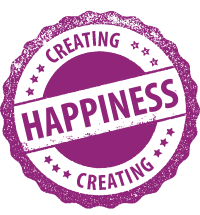In my previous blog, “Creating Healthy Thinking Patterns: Your Brain Does Not Come Up With Truth, and Thought and Thinking Are Two Different Things”, I invited you to write down a list of all your painful thoughts (aka stories, I will use both of them interchangeably) that leave you feeling miserable. If you still have it, now is the time to take it out. We will put it to good use.
Today you will learn to replace those lousy thoughts, which most likely have been torturing you for a while, with much better ones. I am feeling excited as I am looking forward to sharing with you this mental health tool because it is so liberating and empowering.
The tool I like to use with my clients for this purpose is loosely based on a CBT technique by Katie Byron, called thought mediation. The goal is to slow down and examine a painful thought by applying four simple questions.
To become aware that your thought is just a story you tell yourself, to realize the impact this story has on your life, and to find an equally valid story which will serve you better. This will move you from being a reactive to a proactive thinker, from a stance of victimhood to empowerment.
Our emotions often follow our thinking. I cannot target emotions directly when working with clients, but I can show them how to change their thinking process and through that more positive emotions will follow. In short, bad thinking habits lead to mental health problems, good thinking habits can play a key role in reversing them.
Ok, let’s begin.
1. Choose your most painful thought.
Take out your list and identify your most painful thought. Look for a story with a lot of emotional discomfort attached to it, like, “I am flawed and unworthy of love, nobody will ever want to be with me”, or, ” I am a useless failure, I don’t deserve being a father”. Often, the most painful thoughts will be connected to stories around not being ok, not being good enough, or being unworthy.
Write down your painful belief on a piece of paper and then ask yourself the following questions.
2. Can you absolutely know this thought is true?
Can you absolutely know that your thought is true and that you are flawed and unworthy of love, or, can you absolutely know that you are a useless failure and don’t deserve to be a dad, or is there a chance that you might be wrong?
This question might be difficult for you to answer at first. You might not be sure and your brain might still insist that your story is absolutely right. However, after pondering it for a while, a faint whisper might arise suggesting that there might be a possibility that your self-defeating belief is false.
Just because you have a thought, it does not mean that it is true. Your brain does not come up with truth, it just comes up with a random array of stories.
3. What happens when you believe that thought?
When you believe the thought, does it bring you peace or stress? What physical sensations and mental images come with it? What do you feel? How do you treat yourself and others?
This step will allow you to get in touch with the full impact this toxic thought has on your overall well-being. Most likely, your painful thought will trigger stress, muscle tension, painful mental images, and will have a negative impact on how you relate to yourself and others.
5. Who would you be without that thought?
Check in with yourself for a moment, who would you be without that toxic belief? How would you feel in your body? What kind of thoughts and feelings would you have? How would you feel about yourself and the world?
Most likely, you would feel so much lighter and happier. It would feel like a ton of bricks has been lifted off your shoulders.
6. Turn the thought around and find an equally valid, more useful thought.
This is my favourite part. Here you are invited to be playful and find an equally valid, if not more valid thought, that allows you to have a more positive emotional experience. By now you know that just because you have a thought, it does not mean that it is true, and that you have the right to pick an alternative thought that works better for you.
For example, you could flip the original belief around and do a 180. You could say to yourself, “I am whole and worthy of love and I will do all I can to create a meaningful relationship in my life”, or, “I made mistakes but that does not make me a failure. I will choose to learn from my mistakes and do my best to be a good dad now”. Those new stories might be close to being the opposite of the original toxic ones. They are both equally true, if not truer, and will come with much nicer emotions attached to them.
Or, you could replace your original toxic belief with a totally new thought like, “I am done with wasting my time putting myself down, from now on I will have my back and choose more encouraging thoughts”. There is an unlimited amount of more useful, equally valid thoughts you can pick from, the possibilities are endless.
The next time your old painful thought emerges, it will no longer have the power to keep you hostage, as now you come prepared with your new replacements thoughts. And, each time when you swap the toxic belief for a productive one, your mental health will thank you. You now know how to take charge of your thinking process and increase your overall well-being by choosing good stories.
Reference:
Loving What Is: Four Questions That Can Change Your Life by Katie Byron (2002)

This post is part of the blog series "Creating Happiness", your inspiration to promote positive change in your life.
Do you like Daniela's posts? Subscribe to her blog series:
ABOUT THE AUTHOR
Ms Daniela Beer-Becker, Psychologist
Daniela is a regular contributor to the Blake Psychology blog and author of the "Creating Happiness" series.
MORE POSTS IN THE SERIES
















